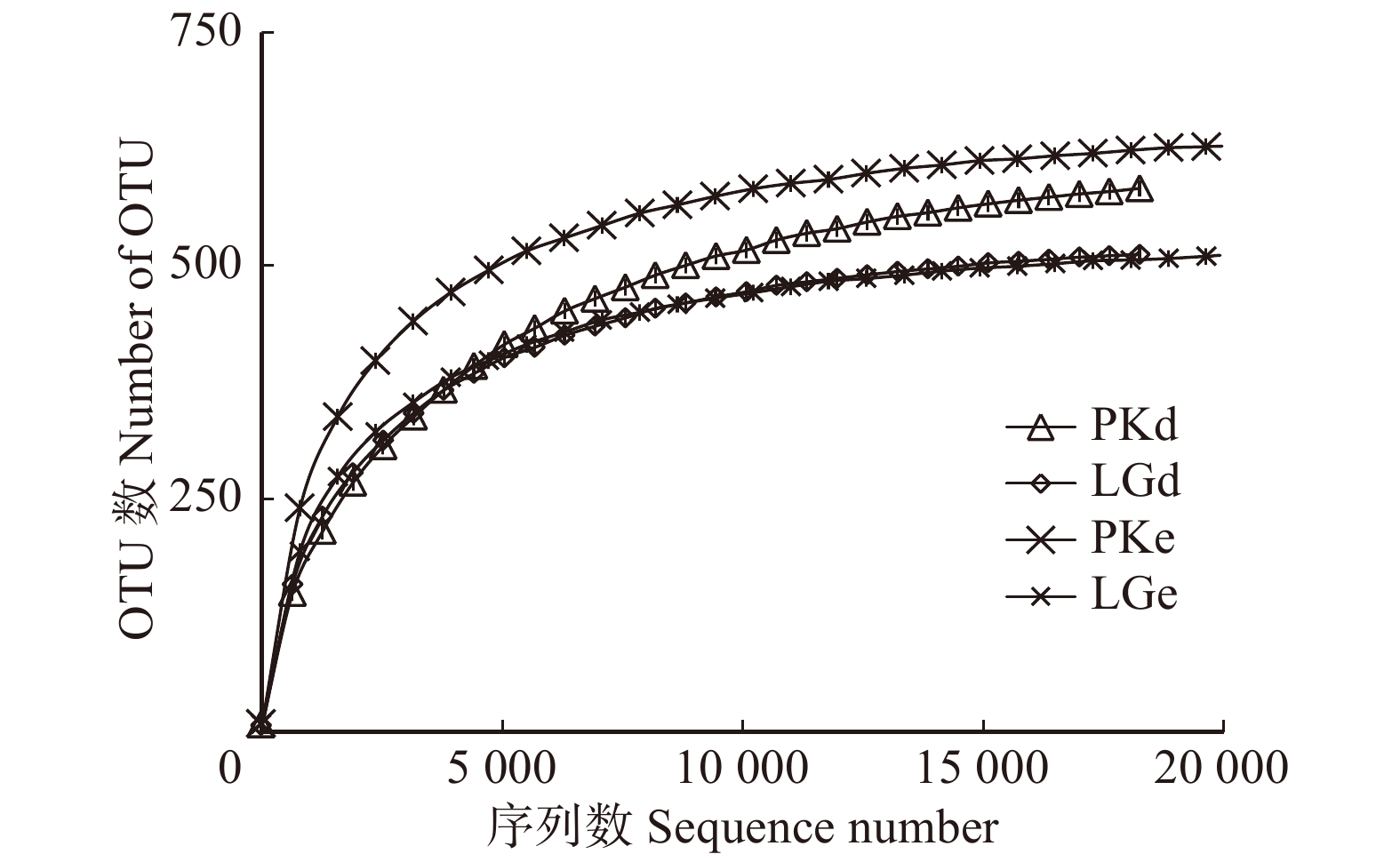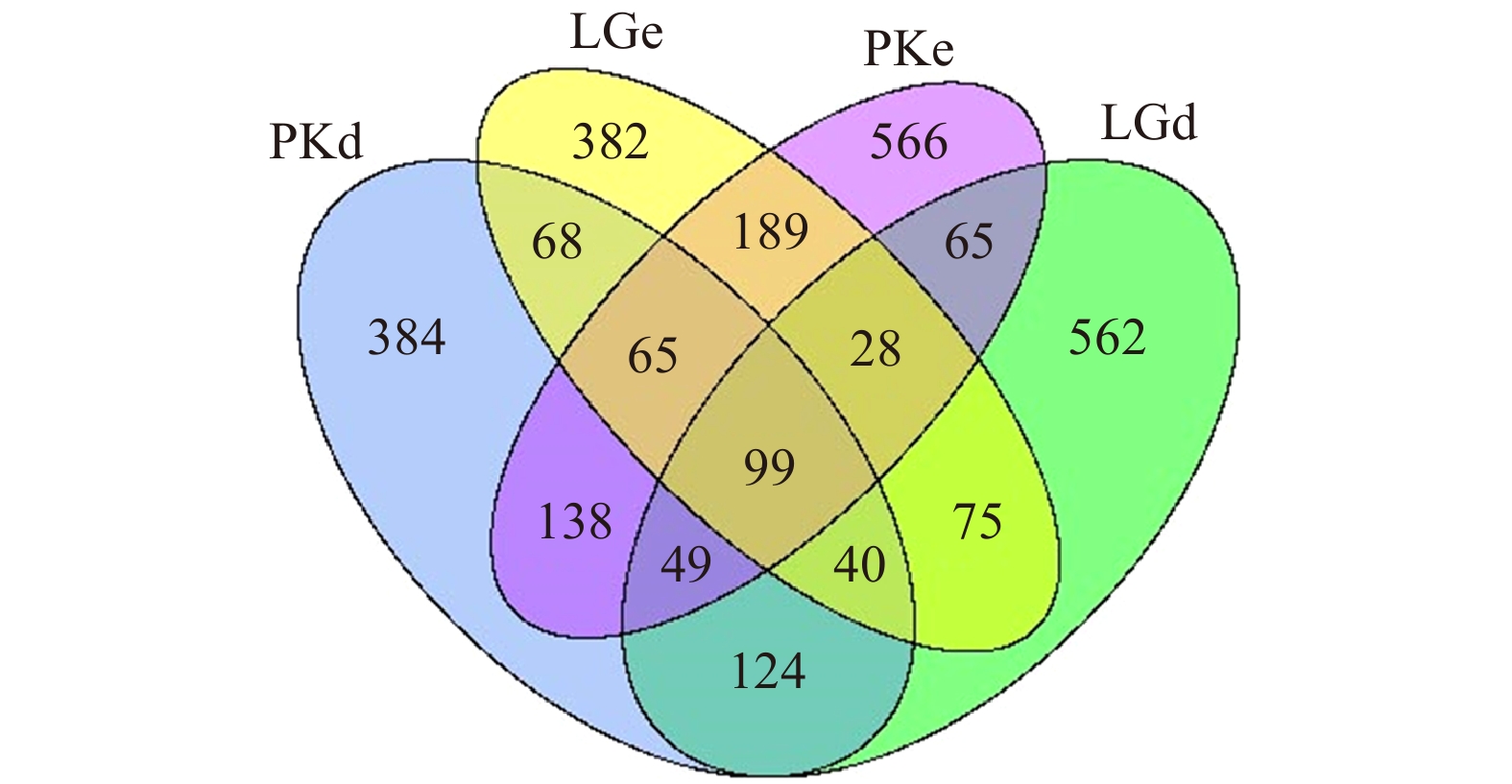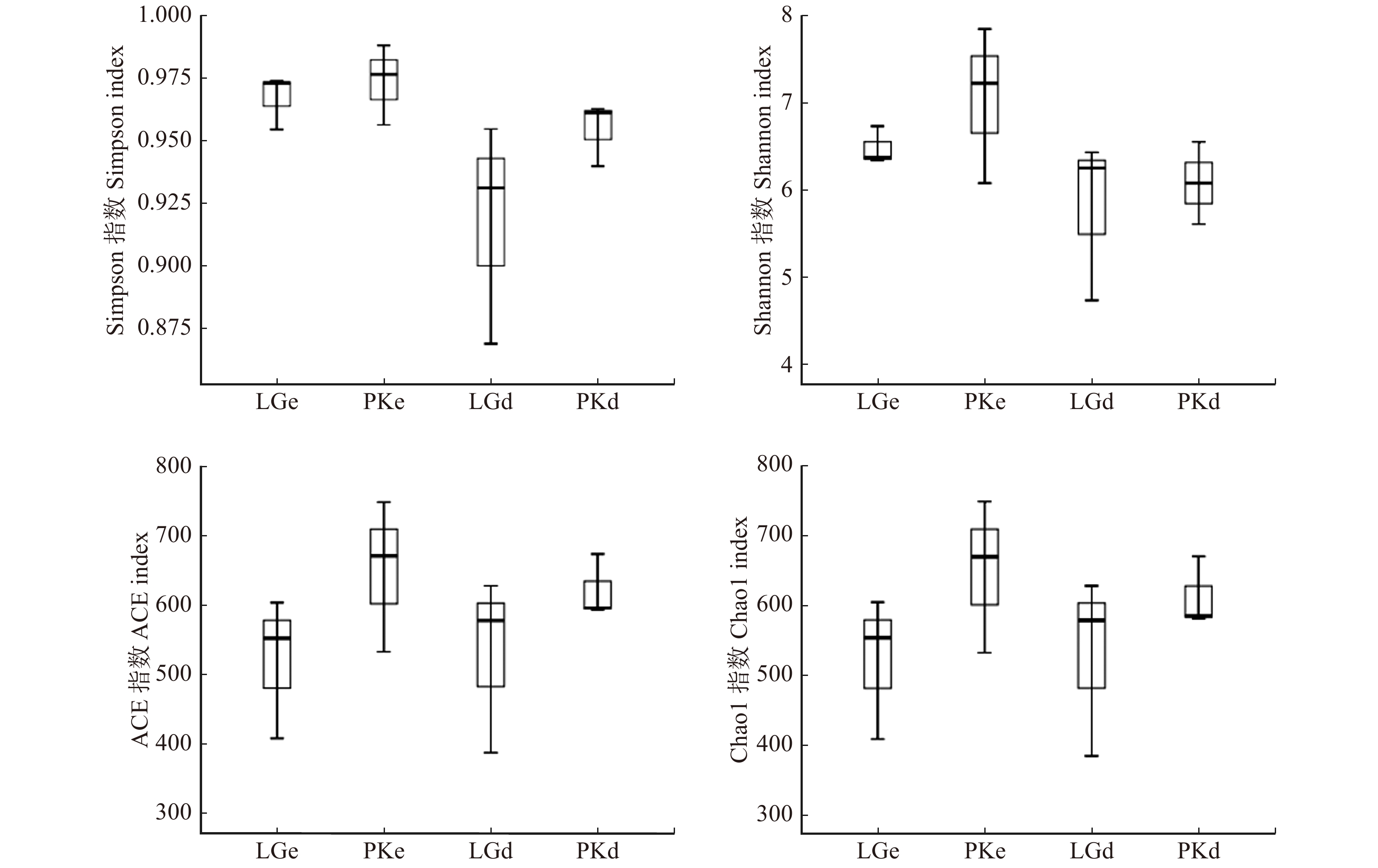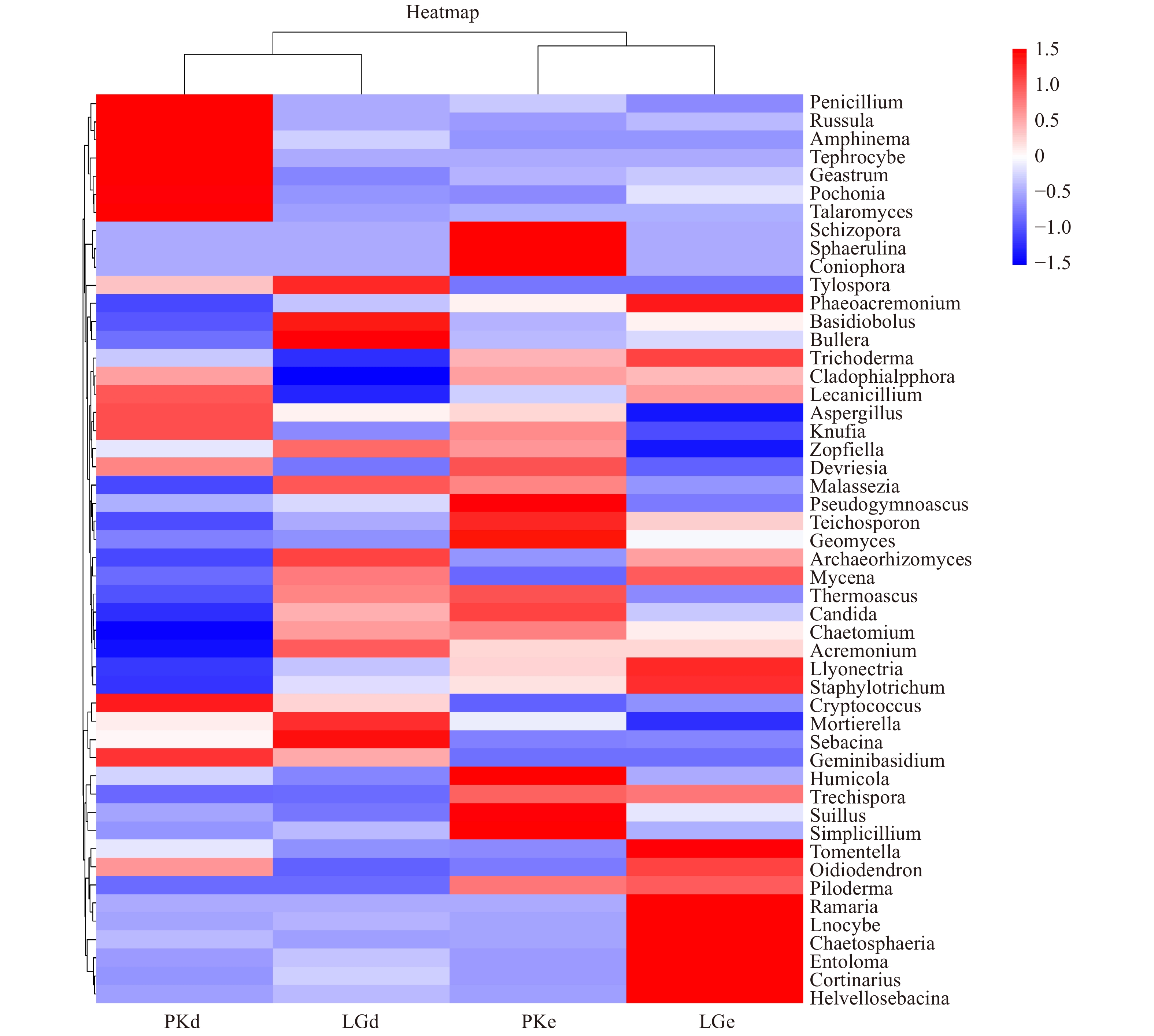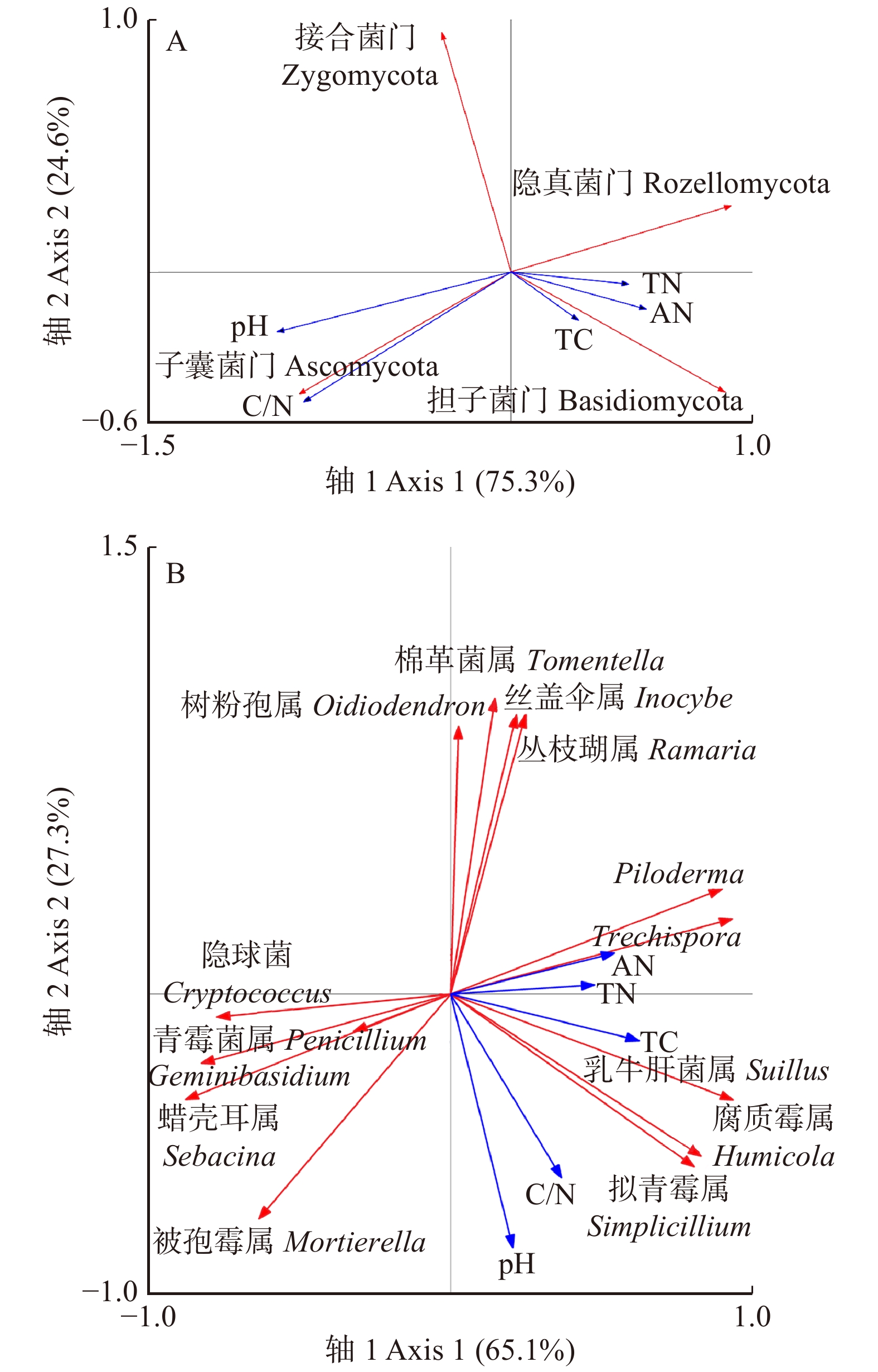Characteristics of soil fungal community structure at two coniferous plantations in mountainous region of eastern Liaoning Province, northeastern China
-
摘要:目的为探讨辽东山区两种典型针叶人工林土壤真菌群落多样性及结构特征,揭示真菌群落结构与树种、土壤环境因子的相关性。方法本研究以辽东山区白石砬子自然保护区内落叶松(LGe)、红松(PKe)人工林和辽宁省森林经营研究所实验林场落叶松(LGd)、红松(PKd)为研究对象,采用Illunima Miseq高通量测序技术和OTU分析法比较不同针叶人工林土壤真菌群落结构差异,分析优势菌群与土壤理化性质的相关性。结果(1)与红松人工林相比,落叶松人工林有助于提高土壤全碳、全氮和速效氮的含量。(2)该区落叶松和红松人工林土壤共检测到9个土壤真菌门,优势菌门为担子菌门、子囊菌门、接合菌门和隐真菌门。(3)LGe和PKe,LGd和PKd土壤真菌的多样性和丰富度指数存在差异,但都不显著。(4)Venn和Heatmap表明落叶松和红松人工林土壤真菌群落组成和相对丰度存在差异,LGe和PKe间的差异较LGd和PKd间的差异小。(5)RDA分析与Pearson相关性分析表明,土壤pH、土壤全碳、速效氮、土壤碳氮比是该区针叶人工林土壤真菌群落结构变化的关键影响因素。结论土壤真菌群落结构、多样性指数在不同树种间存在一定差异,LGe和PKe土壤有机质和真菌群落结构多样性差异较小,表现趋同性,LGd和PKd差异较大。Abstract:ObjectiveThis paper aims understand the diversity and community structure of soil fungi in different coniferous plantations in mountainous region of Eastern Liaoning Province, China, and reveal the relationship between fungal community diversity and structure and forest types as well as soil environment factors.MethodEnvironmental genomics approaches, including Illumina MiSeq high throughput sequencing and OTU analysis, were used to assess the composition and structure of fungal community in Larix gmelinii (LGe) and Pinus koraiensis (PKe) in Beshila Nature Reserve, Larix gmelinii (LGd) and Pinus koraiensis (PKd) in the experimental forest farm of Liaoning Institute of Forest Management in Montane Region of Eastern Liaoning Province.Result(1) Compared with Pinus koraiensis, Larix gmelinii can improve the contents of total carbon, total nitrogen and available nitrogen in soil. (2) The results showed that 9 different fungal phyla were identified in the soil of Larix gmelinii and Pinus koraiensis plants. The dominant fungal phylum groups were Basidiomycota, Ascomycota, Zygomycota and Rozellomycota. (3) Structurally, there were no significant difference in diversity indices and richness indices between LGe and PKe, so were LGd and PKd. (4) The Venn diagram and heatmap showed that the fungal community composition and relative abundance of Larix gmelinii and Pinus koraiensis plants were different, and the difference between LGe and PKe was smaller than that between LGd and PKd. (5) Redundant analysis and correlation analysis indicated that soil pH, TC, AN and C/N were the main factors which affected the community structure of coniferous forests in this area.Conclusion This work showed that there were some differences in soil fungal community structure and diversity index among different forest types. The soil organic matter and fungal communities of the LGe and PKe showed small discrepancy compared with LGd and PKd, and planting Larix gmelinii helps improve soil fertility.
-
坡面薄层流是降雨在扣除截留、填洼、下渗等损失后沿坡面形成的浅层明流[1],是一种特殊而复杂的水流形态。研究表明,坡面薄层流不同于一般的明渠水流,水深一般只有几毫米甚至零点几毫米,薄层水流流向不稳定,沿程有质量源和动量源汇入,产生能量紊动,且受地表状况、雨强等诸多因素的影响,所以对坡面薄层水流的研究难度较大[2-4]。而坡面流是径流初始阶段和侵蚀演变的初始动力,其水动学特性对阐明土壤侵蚀和坡面产沙机理具有重要理论意义[5-8]。
目前,对于薄层水流特性的研究热点聚焦于坡面流流态及坡面流阻力特性,关于其流态归属问题,Horton等[9]认为坡面薄层水流是紊流中点缀层流的一种混合流区;Emmett[10]认为坡面流虽有紊流特性,但仍展现出较多层流性质,故定义为“扰动流”;Selby[11]认为坡面流是紊流和层流的混合流区。但仍然缺少公认的薄层流流态的界定方法。关于薄层水流阻力规律的研究,已有的研究成果多应用二元流雷诺数判别准则进行流区划分[4-5, 12]。关于降雨对坡面流阻力的影响,大部分的研究都表明,降雨对水流阻力的影响程度与水流流态有关,雨滴的打击作用和动能输入使其阻力增大,降雨在伪层流[4]情况下对水流阻力的影响最为显著,而有的学者认为降雨影响可以忽略[13]。而对于薄层水流特性的研究方法聚焦于人工模拟降雨或者水槽放水冲刷,两者共同作用下的水动力学特性研究十分少见。潘成忠等[13]通过上方来水和模拟降雨试验,研究了不同流量和坡度条件下坡面薄层水流水力学参数和滚波特性,初步探明了降雨和坡度对它们的影响。目前,对于坡面水流特性的探讨虽有不少研究成果,但由于坡度较小、床面光滑、缺少试验资料等因素,其结论的实际应用性也受到很大程度的限制,尤其在山地陡坡、雨量急、大的情况下。坡面流其底坡较天然明渠陡峭得多,重力作用更为突出。自然中,在山地陡坡、大雨条件下会发生超渗产流现象,坡面流冲刷和降雨同时作用于坡面,二者综合作用力对坡面的影响目前尚未明确。在国外,坡面流水动力学特性研究多侧重于缓坡,而国内多侧重于细沟水流,有研究表明,20°~ 25°是坡地土壤侵蚀的临界坡度[14]。目前针对陡坡和降雨对坡面流水流特性的研究尚显不足。与缓坡相比,陡坡条件下的水流动力特性和侵蚀特征具有其特殊性[15-16]。所以研究坡面流冲刷和降雨共同作用下的陡坡坡面流水动力学特性对防治水土流失有重要意义。
本文采用陡坡坡面定床阻力试验,通过人工模拟降雨和放水冲刷试验相结合的方法,定量研究5种流量和4个典型降雨强度(含无降雨)条件下,受4种不同粗糙度影响的水力要素关系及阻力的变化特征。研究陡坡降雨条件下的薄层水流水动力学特性对于揭示坡面薄层水流阻力的内在规律具有重要理论意义。
1. 研究区概况
缙云山位于三峡库区内,是国家级自然保护区,地理坐标为106°17′~106°24′ E、29°41′~29°52′ N,属于典型的亚热带季风湿润气候,植被资源丰富,森林覆盖率达96.6%。占地面积76 km2,海拔350.0~951.5 m,年平均降水量1 611.8 mm,最高年降水量1 683.8 mm。降雨主要发生在4—9月,降水量1 243.8 mm,占全年的77.2%。相对湿度年平均值为87%,年平均气温13.6 ℃。缙云山多雾,日照时数少,年平均雾日数高达89.8 d,年平均日照时数则低于1 293 h。缙云山地形平缓,土层深厚,土壤肥力高,以三叠纪须家河组厚层石英砂岩、灰质页岩和泥质页岩为木质风化而成的酸性黄壤土为主。试验研究林总面积约为33.5 hm2。保护区主要树种为四川大头茶(Gordonia acuminata)、杉木(Cunninghamia lanceolata)、马尾松(Pinus massoniana)、四川山矾(Symplocos setchuensis)、川杨桐(Adinandra bockiana)、广东山胡椒(Lindera kwangtungensis)、毛竹(Phyllostachys heterocycla)、细齿叶柃(Eurya nitida)等。
2. 试验方法
试验时间为2016年7—9月。具有固定的不透水下垫面和一定粗糙度的坡面称为定床阻力坡面,为了便于测量和控制浅层水流的边界条件,本试验采用坡面定床阻力试验,在模拟天然地表粗糙度的同时也消除了床面形态变化对水流紊动的影响[17-22]。试验对降雨和坡面流共同作用下的坡面薄层流水动力学特性进行研究。
试验水槽结构示意图如图 1所示,试验水槽结构尺度为长4.0 m,宽0.4 m,深0.1 m,在进水口管道安装精度为0.001 m3/h的流量计用于测量流量,每次试验开始前进行流量率定,保证在设计流量允许误差范围内。为模拟缙云山陡坡条件下的坡面流,坡度恒定设置为20°。为保证水流波动仅由水砂纸糙度引起,同时减小水槽边壁对水流的影响,故在水槽侧壁刷清漆,在水槽底部黏贴有机玻璃板,有机玻璃板与水槽侧壁的黏合使用玻璃胶,用刀片将边缘刮平,水砂布黏贴在有机玻璃板上。
通过黏贴水砂布设置4种不同下垫面,其中3种分别为40、60、80目水砂布床面,另外一种为光滑坡面。按照尼库拉兹提出的床面粗糙度(ks)表示方法,试验粗糙度(ks)分别为0.009(光滑坡面)、0.180、0.250、0.425 mm,分别对应缙云山不同土壤粒径的裸土表面。根据重庆缙云山的坡面径流小区监测的产流情况,同时也考虑到尽可能使水深取值范围较大,设计进口放水流量为0.486×10-3、0.694×10-3、1.042×10-3、1.389×10-3和1.736×10-3 m3/(s·m)共5个试验处理。根据重庆缙云山典型降雨强度,设计降雨强度分别为30、60和100 mm/h和无降雨。本试验采用侧喷式降雨机模拟天然降雨。天然降雨的主要特性包括降雨分布的均匀性、降雨强度、雨滴直径大小、雨滴的终点速度等。目前大多数科学试验都是以上述降雨特征作为人工模拟降雨的评价标准[23]。在试验区域内用烧杯收集降雨并采用体积法测量雨量,计算降雨均匀度在85%以上,一般要求0.8以上[24],部分能达到90%。实际降雨强度与设计降雨强度之差与设计降雨强度的比值为降雨强度误差,其值在5%以内。真实降雨雨滴直径通常为0.1~6.5 mm,本试验降雨强度为30~100 mm/h时,雨滴中数直径为1.32~2.05 mm[25]。天然降雨雨滴的终点速度为2.0~2.9 mm/s,研究表明降雨高度为7~8 m时,95%雨滴达到相应的终点速度[26];高度大于4.3 m时,大雨滴达到终点速度的80%[27];具有初速度的下喷式喷头,降雨高度达2 m时,不同直径的雨滴可以获得终点速度[25]。本装置采用喷嘴式喷头(具有初速度),有效降雨高度为6 m,可以满足2.0~2.9 mm/s的终点速度。降雨试验场次设计采用雨强、粗糙度与放水流量的完全组合试验并重复试验一次,共4×4×5×2=160场降雨。
沿水槽自上而下设纵向水深观测断面3个,分别距槽顶1.0、2.0和3.0 m,每个观测断面横向设3个间距等分观测点(图 1),即每个工况下测量9次水深,求平均值获得该工况下的平均水深。水深采用水位测针仪测定,精度为0.1 mm。断面表层流速采用KMnO4染色示踪法测定,选择水槽中部实验段3 m测量流速[28],在水流表面滴入染色剂并记录时间与试验段距离,以此反映坡面流的表层流速,6次重复,求平均值获得该工况下的平均表层流速。
水动力学参数计算公式如表 1。
表 1 水力参数计算Table 1. Calculation of hydraulic parameters公式序号
Formula order No.公式Formula 符号及其意义Symbol and its meaning (1) u=qh u为断面平均流速,m/s;q为单宽流量,m3/(m·s);h为实测断面平均水深,cm
u is mean velocity, m/s; q is unit discharge, m3/(m·s); h is measured flow depth, cm(2) α=uus α为流速修正系数;us为表层流速,m/s
α is velocity correction factor; us is velocity, m/s(3) u=ηq1−mJn m为流态指数; J为水流坡降,可近似取sin θ; θ为水槽坡度;η和n为拟合函数中的系数
m is flow-state indicator; J is hydraulic slope which closes to sin θ; θ is slope of flume; η and n are coefficient of the fitting function(4) Re=uRv Re为雷诺数;R为水力半径,m,薄层水流可视为二元流,水力半径近似等于断面平均水深h;υ为运动黏滞系数,cm2/s;υ=0.017 75/(1+0.033 7t+0.000 22t2),t为水温,℃
Re is Reynolds number; R is hydraulic radius, m, overland flow is regarded as binary stream so R closes to h; υ is coefficient of kinematic viscosity, cm2/s. υ=0.017 75/(1+0.033 7t+0.000 22t2). t is water temperature, ℃(5) Fr=u√gh Fr为弗劳德数;g为重力加速度Fr is froude number and g is gravitational acceleration (6) f=8gRJu2 f为阻力系数f is resistance coefficient 3. 结果与分析
3.1 平均流速及流速修正系数
由流量计测得的流量与水槽宽度之比为单宽流量,不同工况下坡面流的平均流速可以通过公式(1)u=qh计算得到,即单宽流量与实测断面平均水深之比,平均流速精度为0.01 m/s,误差为5%。图 2为不同降雨强度下平均流速随单宽流量的变化规律,由图可知降雨时,水流的平均流速随着单宽流量的增大呈幂函数增加趋势,随粗糙度的增加而减小。一般认为,由于雨滴击溅作用产生的附加阻力会使流速减小,而在本试验坡度条件下,降雨对平均流速有增加作用,但是不同降雨强度影响间差异不明显,这可能与陡坡条件下雨滴动量沿坡面分量较大有关[13]。粗糙度和降雨强度相同时,单宽流量增大一倍时平均流速增加68.7%,说明单宽流量对平均流速影响显著。在无降雨条件下,平均流速增幅较为稳定,水流的平均流速随单宽流量的增加呈幂函数增加,随粗糙度的增加而减小。无降雨时水流平均流速与单宽流量和与粗糙度的定性关系与以往结果一致[15, 19-20]。
在本试验给定的降雨和坡面流条件下,流量和粗糙度对平均流速影响显著,降雨主要起到扰动坡面流的作用,有增大坡面平均流速的趋势。
流速修正系数表示坡面流平均流速(u)与表层流速(us)的比值,坡面薄层流的水深较薄,难以直接观测水流垂线流速分布,只能通过探究流速修正系数的变化规律间接研究流速的垂线分布。图 3为不同降雨条件下流速修正系数随平均流速的变化规律,由图可知,无降雨时,流速系数随着平均流速的增加而增加,流速修正系数范围为0.04~0.37,数值偏小,且粗糙度间的流速系数差异较小。说明无降雨时坡面流的流速梯度较大,流速分布不均匀,粗糙坡面对底层流速的阻碍作用明显。降雨时,流速修正系数取值范围为0.42~0.98,随着粗糙度的增大而增大,随着平均流速的增加而增加。降雨条件下的流速修正系数数值相对较大且分布较为分散,最大值接近1。
表 2为收集和整理的以往试验数据,由表 2可知,降雨时流速修正系数数值偏大,最大值将近1。降雨对坡面流表层水流产生击溅作用,薄层水流内部产生扰动。当降雨强度增大时,薄层流内部扰动越来越大,水流上下层的流速差异越来越小,流速梯度越小。所以,降雨时流速修正系数整体比无降雨条件下的大。
表 2 收集数据及试验数据概况Table 2. Overview of literature datasets and experimental data资料来源
Source of date中值粒径
Median size
(d50)/mm坡度
Slope degree
(J)/(°)降雨强度
Rainfall intensity
P/(mm·h-1)单宽流量
Unit discharges×
10-3(q)/(m2·s-1)水深
Depth of water
(h)/mm雷诺数
Reynolds
number (Re)流速修正系数
Velocity correction
factor (α)文献[13] Literature [13] 1.5~15 0 0.08、0.25 0.27~1.37 320~998 0.40~0.70 文献[13] Literature [13] 1.5~15 30 0.08、0.25 0.31~1.48 409~1 097 0.41~0.67 文献[29] Literature [29] 0.4、0.67 1.2 0 0.01~0.06 0.84~1.33 26~102 0.56~0.61 文献[30] Literature [30] 0.74 3.5、5.5 0 0.13~1.46 2.37~5.79 295~3 188 0.33~0.86 本文This paper 0.009~0.425 20 0 0.49~1.74 0.7~5.9 142~842 0.04~0.37 本文This paper 0.009~0.425 20 30、60、100 0.49~1.74 2.0~6.0 514~1 862 0.42~0.98 从流速修正系数角度同样可以得到粗糙度对流速影响显著,降雨主要起到扰动坡面流的作用。
3.2 流态指数
张宽地等[31]提出流态指数概念,m被认为是与流态相关的指数,流态指数反应了单宽流量对坡面水流流速的影响程度,即水流耗能的主要形式。m值范围在0到1之间,m值越大,水流能留转化为动能较少,此时以阻力做功为主,反之,则以水流转化为动能为主。
由表 3可知,本实验条件下,流态多数在过渡流区,少数处于层流区,流态指数范围为0.291~0.538,平均值为0.418。由表 3和图 4可知,无降雨时,流态指数随着粗糙度的增加而明显减小,随着粗糙度的增大其减小程度分别为21%、28%和39%;中小雨强时,流态指数无明显规律,雨强为30 mm/h时,变化程度分别为18%、-29%和12%,雨强为60 mm/h时,变化程度分别为12%、-17%和-16%;大雨强时,流态指数呈现出较为明显下降的趋势,随着粗糙度的增大其变化程度分别为-6%、1%和-11%。降雨扰动造成了流态的复杂性。坡面水流流态指数m值的影响因素比较复杂[1],无降雨时,影响水流状态的主要因素为粗糙度,粗糙度较小时,水流水面失稳产生滚波,阻力作功耗能居主要地位,粗糙度较大时,坡面凹凸影响滚波发育,水流紊动强度较低,增加水流流速耗能居主要地位。中小雨强时,流态指数无明显规律,说明降雨是造成流态指数不稳定的关键因素(F=4.55>F0.05=3.86)(见表 4),降雨对水面的击溅作用扰动水面,增加水流的紊动强度。大雨强时,流态指数呈现出较为明显下降的趋势。说明随着粗糙度的增加,水流从阻力做功耗能居主要地位发展到能量转化动能居主要地位,侧面反应出流速梯度逐渐增大,可能是由于陡坡条件下雨强的击溅对流速有促进作用。
表 3 各实验组次流态指数m的实测值Table 3. Measured m value of different experimental groups粗糙度Surface
roughness/mm降雨强度Rainfall intensity/(mm·h-1) 0 30 60 100 0.009 0.477 0.412 0.398 0.532 0.180 0.378 0.486 0.446 0.501 0.425 0.343 0.291 0.331 0.537 0.380 0.290 0.463 0.334 0.473 表 4 各实验组次流态指数m方差分析Table 4. Variance analysis of m of different experimental groups变异来源Source of variation SS df MS F F0.05 F0.01 粗糙度间Among surface roughness 0.021 3 0.006 9 1.895 3.86 6.99 雨强间Among rainfall intensities 0.050 3 0.016 5 4.549* 3.86 6.99 误差Error 0.033 9 0.003 6 总变异Total variation 0.104 15 注:SS表示平方和;MS表示平均平方和;F表示平方和之比;F0.05和F0.01表示显著水平。Notes: SS represents sum of square; MS represents average sum of square; F is ratio of SS; F0.05 and F0.01 represent significant levels. 无降雨时,在试验粗糙度范围内,较大试验坡度的流态指数随着粗糙度的增加而明显减小,这与张宽地等[1]研究中的变化趋势相同,粗糙度继续增大时流态指数是否增加有待进一步研究。分析本试验的流态指数变化趋势,降雨引起水面失稳并产生滚波,其可能会影响水流流态。潘成忠等[13]认为降雨对断面滚波数具有增加效应,而对波高和波长影响不显著。在坡面薄层水流试验中,滚波可能是进一步的研究重点。
3.3 水流流型流态
水流流区是指坡面内的紊动水能,分为层流区、过渡区和紊流区,根据雷诺数Re判断,水流流型是指坡面流是缓流、临界流还是急流,根据弗劳德数Fr判断[22]。张宽地等[31]综合考虑雷诺数和弗劳德数对水流流态的判断标准,Re=500、Re=2 000和Fr=1将水流分为6区流态(图 5),分别是缓层流、缓过渡流、缓紊流、急层流、急过渡流和急紊流。将判断流态的雷诺数和判断流型的弗劳德数综合体现于一张图中,能够更为清晰地说明降雨、粗糙度和流量对坡面流状态的综合影响。
![]() 图 5 不同降雨条件下水流流态分区A.缓紊流区; B.缓过渡流区;C.急紊流区;D.缓层流区;E.急过渡流区;F.急层流区。Figure 5. Flow state zoning under different rainfall conditionsA, subcritical turbutent flow; B, subcritical transition flow; C, supercritical turbulent flow; D, subcritical laminar flow; E, supercritical transition flow; F, supercritical laminar flow.
图 5 不同降雨条件下水流流态分区A.缓紊流区; B.缓过渡流区;C.急紊流区;D.缓层流区;E.急过渡流区;F.急层流区。Figure 5. Flow state zoning under different rainfall conditionsA, subcritical turbutent flow; B, subcritical transition flow; C, supercritical turbulent flow; D, subcritical laminar flow; E, supercritical transition flow; F, supercritical laminar flow.陡坡时,在降雨和坡面流胁迫下,水流雷诺数为500~2 000,水流流态均属于层紊流过渡区,且多数属于急流区,少数属于缓流区。说明较大坡度增大了重力方向的分力,水流耗能主要以增加流速为主[13]。图 5a中,ks=0.425 mm时,雷诺数数值上是层流,然而实际中存在滚波现象,不符合“层层不混搀”的层流特性,因而属于“伪层流”[4]。模拟降雨条件下的薄层水流流态与流量密切相关,随着流量的增加,水流流态由层流区向过渡流区延伸[31]。
由图 5可知,粗糙度对坡面薄层流流态起重要作用。无雨时,坡面颗粒越大水流越趋近缓流,这与敬向锋等[22]得到的“床面越粗糙坡面流流态越倾向于向层流区延伸”结果一致。在水流运动过程中,遇到颗粒产生绕流,绕流过程中流速方向改变,流速大小减小,动能减少而阻力作功增加,粗糙程度越大,坡面对水流流动形成的阻力越大,流速减缓越显著。降雨时,粗糙度与流态不再具有相关关系。说明降雨对坡面流的击溅作用使薄层流产生扰动,所以水流流态均不处于层流区,多数处于急过渡流区,扰动程度相对削弱粗糙度对流态的影响。
与无降雨的坡面流相比,有降雨水流更趋向急流,说明降雨起到增加流速的作用。一般认为,由于雨滴击溅作用产生的附加阻力会使流速减小,张宽地等[1]通过试验认为在坡度较大(大于10.5%)条件下,基本上降雨均不同程度地增大表层流速,这与本试验结果一致,可能主要是因为陡坡条件下雨滴动量沿坡面的分量较大有关,能量更多地转化为动能。雨强越大,能够转化为动能的能量越多。
3.4 阻力特征
本试验在降雨条件下通过砂纸模拟下垫面,阻力规律只考虑颗粒阻力和降雨阻力的综合体现。
由图 6可知,坡面薄层流阻力系数与雷诺数呈负相关关系,随着雷诺数的增加阻力系数逐渐减小,且减小的幅度越来越小,最后趋于稳定。说明随着流量的增大,水流克服阻力所消耗的能量增加,而用于坡面侵蚀的能量减小。随着流量的增大,水深增加到一定程度后,坡面水砂纸处于完全淹没状态,由于水砂纸引起的坡面粗糙无法影响到主流区,该工况下阻力系数与雷诺数无关,而是趋近于一个常数。
降雨对坡面水流阻力系数的影响目前并无定论,吴普特等[32]认为降雨减少水流摩阻系数,但潘成忠等[13]认为降雨对坡面阻力系数无显著影响。本实验中与有降雨相比,无降雨时的阻力系数相对稳定,无明显波动。说明本实验条件下,降雨对坡面阻力系数的影响不显著,降雨主要起到扰动坡面流的作用。进一步地,采用逐步回归分析,定量研究糙度(ks)、单宽流量(q)和降雨强度(P) 3个影响因子对坡面流的阻力贡献率,计算结果见表 5。其中,降雨强度被排除,表明其对阻力系数无显著影响;由自变量系数可知,坡面流阻力系数与粗糙度呈正相关,与单宽流量呈负相关,这与上述的讨论相符合。
表 5 达西阻力系数影响因子的逐步回归分析Table 5. Stepwise regression of impact factors of resistance coefficient模型Model 相关变量Related variable 标准系数
Standardized coefficient自变量系数
Independent variable coefficient标准误差Standard error 常量Constant value 3.022 0.611 粗糙度Surface roughness 10.772 1.454 0.533 单宽流量Unit discharge -3 122.434 488.542 -0.460 已有研究成果表明,当颗粒阻力起主要作用时,阻力系数与雷诺数的幂函数关系 f=aRbe 才成立[10],为进一步研究降雨强度对坡面流阻力的影响,将本试验模拟降雨条件下裸坡薄层流数据进行拟合,得到阻力计算公式。
f′=2108.19R−1.227eP0.257,R2=0.3977 (7) 将降雨强度的因式去除,拟合得到阻力计算公式。
f′=5938.16R−1.227eP0.257,R2=0.3976 (8) 式中:f′为阻力系数;P为降雨强度(mm/h)。
对比式(7)和式(8),剔除雨强后,相关系数下降0.01%,说明降雨对坡面阻力系数的影响不显著,降雨主要起到扰动坡面流的作用。王俊杰在模拟降雨条件下得到相关系数下降了7.76%,雨强对于阻力系数的影响不能忽视[21]。这可能是由于下垫面因素不同,与降雨强度大小可能也有关系,降雨对坡面流的作用有待进一步研究。
4. 结论
本实验通过开展陡坡不透水下垫面条件下的模拟人工降雨和水槽放水冲刷试验,基于流态指数和紊动能量耗散规律,定性分析了降雨和坡面流共同作用下的坡面薄层流水动力学特性,得到以下结论。
1) 水流的平均流速随着单宽流量的增大呈幂函数增加,随粗糙度的增加而减小。粗糙度和单宽流量相同时,降雨强度增大一倍引起平均流速的变化程度为15.6%。粗糙度和降雨强度相同时,单宽流量增大一倍引起平均流速的变化程度为68.7%。无降雨时,流速系数随着平均流速的增加而增加,流速系数范围为0.04~0.37,粗糙度间的流速系数差异较小。降雨时,流速系数取值范围为0.42~0.98,随着粗糙度的增大而增大,随着平均流速的增加而增加。降雨条件下的流速修正系数数值相对较大且分布较为分散,最大值接近1。试验降雨下对坡面流起到扰动作用,有增大坡面平均流速的趋势。
2) 流态指数范围为0.291~0.538,无降雨时,流态指数随着粗糙度的增加而明显减小,其减小程度分别为21%、28%和39%;中小雨强时,流态指数无明显规律,雨强为30 mm/h时,变化程度分别为18%、-29%和12%,雨强为60 mm/h时,变化程度分别为12%、-17%和-16%;大雨强时,流态指数呈现出较为明显下降的趋势,其变化程度分别为-6%、1%和-11%。粗糙度继续增大时流态指数是否增加有待进一步研究。降雨引起水面失稳并产生滚波会影响水流流态,所以进一步的坡面薄层水流试验中滚波研究是不可忽略的一部分。
3) 水流雷诺数为500~2 000,所有实验工况下水流流型均属于层紊流过渡区;水流流态整体趋于急流状态;无雨时,粗糙度与流态关系明显,其值越小水流越趋近急流,而降雨时,由于降雨的扰动作用二者不再具有相关关系。
4) 定量研究糙度(ks)、单宽流量(q)和降雨强度(P)3个影响因子对坡面流的阻力贡献率,表明降雨对阻力系数无显著影响,坡面流阻力系数与粗糙度呈正相关关系,与单宽流量呈负相关关系,裸坡条件下考虑雨强影响的坡面流阻力计算公式与剔除雨强的公式相比,相关系数下降0.01%,说明降雨对阻力系数无显著影响,主要起到扰动坡面流的作用。另有研究表明模拟降雨条件下的相关系数下降了7.76%,雨强对于阻力系数的影响不能忽视。所以降雨对坡面流的作用有待进一步研究。
坡面薄层流是坡面径流的初始阶段和侵蚀演变的初始动力,本试验为深入研究降雨和坡面流共同作用下的坡面薄层流水动力学特性提供科学依据,对土壤侵蚀预报模型、水土流失治理方法、泥沙灾害及环境工程等问题均有重要的科学及实践意义。
-
表 1 样地信息
Table 1 Sample plot information
林分类型
Stand type地理坐标
Geographic coordinate海拔
Altitude/m坡度
Slope
degree/(°)坡向
Slope aspect林龄
Foreat age郁闭度
Crown density/%林分密度/(株·hm− 2)
Stand density/
(plant·ha− 1)平均胸径
Mean DBH/cm草本盖度
Herb coverage/%白石砬子自然保护区
落叶松人工林
Larix gmelinii plantation in Baishilazi Nature Reserve (LGe)40°54′46″N、124°47′00″E 734.5 18 东北Northeast 51 85 2 050 18.43 100 白石砬子自然保护区
红松人工林
Pinus koraiensis plantation in Baishilazi Nature Reserve (PKe)40°54′46″N、 124°47′00″E 734.5 18 东北Northeast 51 85 2 115 17.69 100 辽宁省森林经营研究所
实验林场落叶松人工林
Larix gmelinii plantation in the experimental forest farm of Liaoning Institute of Forest Management (LGd)40°52′31″N、 123°56′43″E 340 29 东南Southeast 28 80 2 100 12.68 90 辽宁省森林经营研究所
实验林场红松人工林
Pinus koraiensis plantation in the experimental forest farm of Liaoning Institute of Forest Management (PKd)40°52′31″N、123°56′43″E 340 22 东南Southeast 61 70 1 800 21.94 30 表 2 不同人工林土壤理化性质
Table 2 Chemical properties of soils in different plantation forests
林分类型
Stand typepH 全碳
Total carbon (TC)/(g·kg− 1)全氮
Total N (TN)/(g·kg− 1)速效氮
Available N (AN)/(mg·kg− 1)碳氮比
C/N ratioLGe 5.40 ± 0.04aA 43.79 ± 2.21aA 3.85 ± 0.17aA 33.35 ± 3.21aA 11.36 ± 0.11aA PKe 5.48 ± 0.02aA 41.70 ± 0.58aA 3.58 ± 0.04aA 28.04 ± 1.08aA 11.65 ± 0.27aA LGd 5.57 ± 0.24aA 52.24 ± 3.36aA 3.89 ± 0.27aA 32.05 ± 3.61aA 13.43 ± 0.19aA PKd 5.54 ± 0.11aA 20.08 ± 4.01bB 1.53 ± 3.21bB 12.96 ± 2.56bB 13.24 ± 1.88aA 注:同一列数据不同大写(P < 0.01)和小写(P < 0.05)字母表示差异显著,下同。Notes: different uppercase (P < 0.01) and lowercase (P < 0.05) letters in the same column indicate significant differences. Same as below. 表 3 土壤环境因子与优势真菌类群的相关性分析
Table 3 Correlation analysis between soil environment factors and fungal phylum groups
真菌门类群 Fungal phylum group pH 全碳 TC 全氮 TN 速效氮 AN 碳氮比 C/N ratio 担子菌门Basidiomycota − 0.737 0.343 0.458 0.463 − 0.511 子囊菌门Ascomycota 0.960* − 0.143 − 0.395 − 0.977* 0.996** 接合菌门Zygomycota 0.069 − 0.120 − 0.054 0.245 − 0.252 隐真菌门Rozellomycota − 0.902 0.509 0.714 0.816 − 0.936 注:*表示在P < 0.05水平上显著相关;**表示在P < 0.01水平上显著相关。Notes: * means significant correlation at P < 0.05 level; ** means significant correlation at P < 0.01 level. -
[1] Zhou J, Xue K, Xie J, et al. Microbial mediation of carbon-cycle feedbacks to climate warming[J]. Nature Climate Change, 2012, 2(2): 106−110. doi: 10.1038/nclimate1331
[2] Augé R M. Water relations, drought and vesicular-arbuscular mycorrhizal symbiosis[J]. Mycorrhiza, 2001, 11(1): 3−42. doi: 10.1007/s005720100097
[3] Felske A, Wolterink A, Van Lis R, et al. Response of a soil bacterial community to grassland succession as monitored by 16S rRNA levels of the predominant ribotypes[J]. Applied and Environmental Microbiology, 2000, 66(9): 3998−4003. doi: 10.1128/AEM.66.9.3998-4003.2000
[4] Kuramae E E, Gamper H A, Yergeau E, et al. Microbial secondary succession in a chronosequence of chalk grasslands[J]. The ISME Journal, 2010, 4(5): 711−715. doi: 10.1038/ismej.2010.11
[5] 魏玉莲, 戴玉成. 木材腐朽菌在森林生态系统中的功能[J]. 应用生态学报, 2004, 15(10):1935−1938. doi: 10.3321/j.issn:1001-9332.2004.10.046 Wei Y L, Dai Y C. The ecological function of wood-inhabiting fungi in forest ecosystem[J]. Chinese Journal of Applied Ecology, 2004, 15(10): 1935−1938. doi: 10.3321/j.issn:1001-9332.2004.10.046
[6] 戴玉成. 中国东北地区木材腐朽菌的多样性[J]. 菌物学报, 2010, 29(6):801−818. Dai Y C. Species diversity of wood-decaying fungi in Northeast China[J]. Mycosystema, 2010, 29(6): 801−818.
[7] Timonen S, Finlay R D, Olsson S, et al. Dynamics of phosphorus translocation in intact ectomycorrhizal systems: non-destructive monitoring using a β-scanner[J]. Fems Microbiology Ecology, 1996, 19(3): 171−180.
[8] Gimenez C, Cabrera R, Reina M, et al. Fungal endophytes and their role in plant protection[J]. Current Organic Chemistry, 2007, 11(8): 707−720. doi: 10.2174/138527207780598765
[9] Ownley B H, Gwinn K D, Vega F E. Endophytic fungal entomopathogens with activity against plant pathogens: ecology and evolution[J]. Biocontrol, 2010, 55(1): 113−128. doi: 10.1007/s10526-009-9241-x
[10] Boddington C L, Dodd J C. The effect of agricultural practices on the development of indigenous arbuscular mycorrhizal fungi. (I): field studies in an Indonesian ultisol[J]. Plant and Soil, 2000, 218(1−2): 137−144.
[11] Allison S D, Hanson C A, Treseder K K. Nitrogen fertilization reduces diversity and alters community structure of active fungi in boreal ecosystems[J]. Soil Biology and Biochemistry, 2007, 39(8): 1878−1887. doi: 10.1016/j.soilbio.2007.02.001
[12] 何玉梅, 张仁陟, 张丽华, 等. 不同耕作措施对土壤真菌群落结构与生态特征的影响[J]. 生态学报, 2007, 27(1):113−119. doi: 10.3321/j.issn:1001-9332.2007.01.019 He Y M, Zhang R Z, Zhang L H, et al. Effects of different tillage practices on fungi community structure and ecologic characteristics in loess soils[J]. Acta Ecologica Sinica, 2007, 27(1): 113−119. doi: 10.3321/j.issn:1001-9332.2007.01.019
[13] Harris J. Soil microbial communities and restoration ecology: facilitators or followers[J]. Science, 2009, 325: 573−574. doi: 10.1126/science.1172975
[14] Fierer N, Jackson J A, Vilgalys R, et al. Assessment of soil microbial community structure by use of taxon-specific quantitative PCR assays[J]. Applied and Environmental Microbiology, 2005, 71(7): 4117−4120. doi: 10.1128/AEM.71.7.4117-4120.2005
[15] Girvan M S, Bullimore J, Pretty J N, et al. Soil type is the primary determinant of the composition of the total and active bacterial communities in arable soils[J]. Applied and Environmental Microbiology, 2003, 69(3): 1800−1809. doi: 10.1128/AEM.69.3.1800-1809.2003
[16] Frey S D, Knorr M, Parrent J L, et al. Chronic nitrogen enrichment affects the structure and function of the soil microbial community in temperate hardwood and pine forests[J]. Forest Ecology and Management, 2004, 196(1): 159−171. doi: 10.1016/j.foreco.2004.03.018
[17] Barbi F, Prudent E, Vallon L, et al. Tree species select diverse soil fungal communities expressing different sets of lignocellulolytic enzyme-encoding genes[J]. Soil Biology and Biochemistry, 2016, 100: 149−159. doi: 10.1016/j.soilbio.2016.06.008
[18] 李金前, 赵静杰, 王吉, 等. 3种园林植物土壤真菌群落结构及影响因子[J]. 南昌大学学报(理科版), 2015, 39(5):492−497. doi: 10.3969/j.issn.1006-0464.2015.05.017 Li J Q, Zhao J J, Wang J, et al. Response of soil fungi community to different garden plants[J]. Journal of Nanchang University (Natural Science), 2015, 39(5): 492−497. doi: 10.3969/j.issn.1006-0464.2015.05.017
[19] Yan D F, Mills J G, Gellie N J C, et al. High-throughput eDNA monitoring of fungi to track functional recovery in ecological restoration[J]. Biological Conservation, 2018, 217: 113−120. doi: 10.1016/j.biocon.2017.10.035
[20] 陈晓, 刘勇, 李国雷, 等. 土壤真菌研究方法及人为干扰对森林土壤真菌群落影响研究进展[J]. 世界林业研究, 2011, 24(5):7−12. Chen X, Liu Y, Li G L, et al. Progress on research method of soil fungi and human disturbances to forest soil fungi[J]. World Forestry Research, 2011, 24(5): 7−12.
[21] 范阿南, 刘峰. 辽东山区次生林土壤微生物生物量对微生物呼吸影响[J]. 东北林业大学学报, 2014, 42(3):99−102. doi: 10.3969/j.issn.1000-5382.2014.03.023 Fan A N, Liu F. Seasonal variations of soil microbial biomass and its influence on soil microbial respiration in secondary forest communities in montane region of eastern Liaoning Province[J]. Journal of Northeast Forestry University, 2014, 42(3): 99−102. doi: 10.3969/j.issn.1000-5382.2014.03.023
[22] 肖建强, 张维维, 于立忠, 等. 辽东山区次生林林窗大小对土壤微生物量碳、氮、磷的影响[J]. 生态学杂志, 2017, 36(11):3043−3048. Xiao J Q, Zhang W W, Yu L Z, et al. Effects of gap size on soil microbial biomass carbon, nitrogen and phosphorus in a secondary forest in a montane region of eastern Liaoning Province, China[J]. Chinese Journal of Ecology, 2017, 36(11): 3043−3048.
[23] 邓娇娇, 周永斌, 殷有, 等. 辽东山区典型人工针叶林土壤细菌群落多样性特征[J]. 生态学报, 2019, 39(3):997−1008. Deng J J, Zhou Y B, Yin Y, et al. Soil bacterial community structure characteristics in coniferous forests of montane regions of eastern Liaoning Province, China[J]. Acta Ecologica Sinica, 2019, 39(3): 997−1008.
[24] Gardes M, Bruns T D. ITS primers with enhanced specificity for basidiomycetes-application to the identification of mycorrhizae and rusts[J]. Molecular Ecology, 1993, 2(2): 113−118. doi: 10.1111/j.1365-294X.1993.tb00005.x
[25] White T J, Bruns T, Lee S, et al. Amplification and direct sequencing of fungal ribosomal RNA genes for phylogenetics[J]. PCR Protocols: a Guide to Methods and Applications, 1990, 18(1): 315−322.
[26] Fadrosh D W, Bing M, Gajer P, et al. An improved dual-indexing approach for multiplexed 16S rRNA gene sequencing on the Illumina MiSeq platform[J]. Microbiome, 2014, 2(1): 1−7. doi: 10.1186/2049-2618-2-1
[27] 张于光, 张小全, 刘学端, 等. 不同林型土壤微生物有机碳降解基因的多样性[J]. 生态学报, 2007, 27(4):1412−1419. doi: 10.3321/j.issn:1000-0933.2007.04.019 Zhang Y G, Zhang X Q, Liu X D, et al. The soil microbial gene diversity for soil organic carbon degradation in different forest types[J]. Acta Ecologica Sinica, 2007, 27(4): 1412−1419. doi: 10.3321/j.issn:1000-0933.2007.04.019
[28] 李金博, 朱道光, 崔福星, 等. 寒温带落叶松林不同林型土壤有机碳含量及相关性分析[J]. 国土与自然资源研究, 2015(5):72−75. doi: 10.3969/j.issn.1003-7853.2015.05.022 Li J B, Zhu D G, Cui F X, et al. Analysis on the relationship between soil organic carbon content and soil organic carbon in different leaves of larch in Alpine Region[J]. Territory and Natural Resources Study, 2015(5): 72−75. doi: 10.3969/j.issn.1003-7853.2015.05.022
[29] 向泽宇, 张莉, 张全发, 等. 青海不同林分类型土壤养分与微生物功能多样性[J]. 林业科学, 2014, 50(4):22−31. Xiang Z Y, Zhang L, Zhang Q F, et al. Soil nutrients and microbial functional diversity of different stand types in Qinghai Province[J]. Scientia Silvae Sinicae, 2014, 50(4): 22−31.
[30] 黄志宏, 田大伦, 梁瑞友, 等. 南岭不同林型土壤微生物数量特征分析[J]. 中南林业科技大学学报, 2007, 27(3):1−4. doi: 10.3969/j.issn.1673-9272.2007.03.001 Huang Z H, Tian D L, Liang R Y, et al. Quantitative characteristics of soil micro-organisms of different stands in Nanling Mountains, South China[J]. Journal of Central South University of Forestry and Technology, 2007, 27(3): 1−4. doi: 10.3969/j.issn.1673-9272.2007.03.001
[31] 杨君珑, 付晓莉, 马泽清, 等. 中亚热带5种类型森林土壤微生物群落特征[J]. 环境科学研究, 2015, 28(5):720−727. Yang J L, Fu X L, Ma Z Q, et al. Characteristics of soil microbial community in five forest types in mid-subtropical China[J]. Research of Environmental Sciences, 2015, 28(5): 720−727.
[32] 熊汉锋, 王运华. 梁子湖湿地土壤养分的空间异质性[J]. 植物营养与肥料学报, 2005, 11(5):584−589. doi: 10.3321/j.issn:1008-505X.2005.05.003 Xiong H F, Wang Y H. Spatial variability of soil nutrients in wetland of Liangzi Lake[J]. Plant Nutrition and Fertilizer Science, 2005, 11(5): 584−589. doi: 10.3321/j.issn:1008-505X.2005.05.003
[33] 杨秀清, 韩有志. 关帝山森林土壤有机碳和氮素的空间变异特征[J]. 林业科学研究, 2011, 24(2):223−229. Yang X Q, Han Y Z. Spatial variations of soil organic carbon and nitrogen of forest land in Guandi Mountain[J]. Forest Research, 2011, 24(2): 223−229.
[34] 朱喜, 何志斌, 杜军, 等. 林下植被组成和功能研究进展[J]. 世界林业研究, 2014, 27(5):24−30. Zhu X, He Z B, Du J, et al. Function and composition of understory vegetation: recent advances and trends[J]. World Forestry Research, 2014, 27(5): 24−30.
[35] Lin G G, Mao R, Zhao L, et al. Litter decomposition of a pine plantation is affected by species evenness and soil nitrogen availability[J]. Plant and Soil, 2013, 373(1−2): 649−657. doi: 10.1007/s11104-013-1832-8
[36] Qiao Y, Miao S, Silva L C R, et al. Understory species regulate litter decomposition and accumulation of C and N in forest soils: a long-term dual-isotope experiment[J]. Forest Ecology and Management, 2014, 329: 318−327. doi: 10.1016/j.foreco.2014.04.025
[37] Raich J W, Clark D A, Schwendenmann L, et al. Aboveground tree growth varies with belowground carbon allocation in a tropical rainforest environment[J/OL]. PloS One, 2014, 9(6): e100275 [2018−01−06]. http://www.doc88.com/p-7874450525512.html.
[38] Green J L, Holmes A J, Westoby M, et al. Spatial scaling of microbial eukaryote diversity[J]. Nature, 2004, 432: 747−750. doi: 10.1038/nature03034
[39] 隋心, 张荣涛, 许楠, 等. 三江平原不同退化阶段小叶章湿地土壤真菌群落结构组成变化[J]. 环境科学, 2016, 37(9):3598−3605. Sui X, Zhang R T, Xu N, et al. Fungal community structure of different degeneration deyeuxia angustifolia wetlands in Sanjiang Plain[J]. Environment Science, 2016, 37(9): 3598−3605.
[40] Yelle D J, Ralph J, Lu F, et al. Evidence for cleavage of lignin by a brown rot basidiomycete[J]. Environmental Microbiology, 2008, 10(7): 1844−1849. doi: 10.1111/j.1462-2920.2008.01605.x
[41] Bardgett R D, Mcalister E. The measurement of soil fungal: bacterial biomass ratios as an indicator of ecosystem self-regulation in temperate meadow grasslands[J]. Biology and Fertility of Soils, 1999, 29(3): 282−290. doi: 10.1007/s003740050554
[42] Bossuyt H, Denef K, Six J, et al. Influence of microbial populations and residue quality on aggregate stability[J]. Applied Soil Ecology, 2001, 16(3): 195−208. doi: 10.1016/S0929-1393(00)00116-5
[43] Ma A, Zhuang X, Wu J, et al. Ascomycota members dominate fungal communities during straw residue decomposition in arable soil[J/OL]. Plos One, 2013, 8(6): e66146 [2018−01−11]. https://journals.plos.org/plosone/article?id=10.1371/journal.pone.0066146.
[44] Christina B, Kathrin F, Stephan N, et al. Estimating the phanerozoic history of the ascomycota lineages: combining fossil and molecular data[J]. Molecular Phylogenetics and Evolution, 2014, 78(1): 386−398.
[45] 陈雅昕, 邓娇娇, 周永斌, 等. 蒙古栎天然次生林土壤微生物群落特征及其与土壤理化特性的关系[J]. 沈阳农业大学学报, 2018, 49(4):409−416. Chen Y X, Deng J J, Zhou Y B, et al. Characteristics of soil microbial community and its relationship with soil physical and chemical properties in natural secondary forests of Quercus mongolica[J]. Journal of Shenyang Agricultural University, 2018, 49(4): 409−416.
[46] Paungfoolonhienne C, Yun K Y, Kasinadhuni N R P, et al. Nitrogen fertilizer dose alters fungal communities in sugarcane soil and rhizosphere[J/OL]. Scientific Reports, 2015, 5: 8678 [2018−01−13]. http://www.nature.com/doifinder/10.1038/srep08678.
[47] Lauber C L, Strickland M S, Bradford M A, et al. The influence of soil properties on the structure of bacterial and fungal communities across land-use types[J]. Soil Biology and Biochemistry, 2008, 40(9): 2407−2415. doi: 10.1016/j.soilbio.2008.05.021
[48] Kivlin S N, Hawkes C V. Tree species, spatial heterogeneity, and seasonality drive soil fungal abundance, richness, and composition in Neotropical rainforests[J]. Environmental Microbiology, 2016, 18(12): 4662−4673. doi: 10.1111/1462-2920.13342
[49] 吴照祥, 郝志鹏, 陈永亮, 等. 三七根腐病株根际土壤真菌群落组成与碳源利用特征研究[J]. 菌物学报, 2015, 34(1):65−74. Wu Z X, Hao Z P, Chen Y L, et al. Characterization of fungal community composition and carbon source utilization in the hizosphere soil of Panax notoginseng suffering from root-rotdisease[J]. Mycosystema, 2015, 34(1): 65−74.
[50] 韩世忠, 高人, 李爱萍, 等. 中亚热带地区两种森林植被类型土壤微生物群落结构[J]. 应用生态学报, 2015, 26(7):2151−2158. Han S Z, Gao R, Li A P, et al. Soil microbial community structure of two types of forests in the mid-subtropics of China[J]. Chinese Journal of Applied Ecology, 2015, 26(7): 2151−2158.
[51] Carney K M, Matson P A. Plant communities, soil microorganisms, and soil carbon cycling: does altering the world belowground matter to ecosystem functioning[J]. Ecosystems, 2005, 8(8): 928−940. doi: 10.1007/s10021-005-0047-0
[52] Donnison L M, Griffith G S, Bardgett R D. Determinants of fungal growth and activity in botanically diverse haymeadows: effects of litter type and fertilizer additions[J]. Soil Biology and Biochemistry, 2000, 32(2): 289−294. doi: 10.1016/S0038-0717(99)00160-1
[53] 刘洋, 黄懿梅, 曾全超. 黄土高原不同植被类型下土壤细菌群落特征研究[J]. 环境科学, 2016, 37(10):3931−3938. Liu Y, Huang Y M, Zeng Q C. Soil bacterial communities under different vegetation types in the Loess Plateau[J]. Environment Science, 2016, 37(10): 3931−3938.
[54] Sakamoto K, Oba Y. Effect of fungal to bacterial biomass ratio on the relationship between CO2 evolution and total soil microbial biomass[J]. Biology and Fertility of Soils, 1994, 17(1): 39−44. doi: 10.1007/BF00418670
-
期刊类型引用(3)
1. 李辉,林沂,孟祥爽,史振伟,蔡万园. 基于地基激光雷达的栾树分形特征分析. 山东农业大学学报(自然科学版). 2022(03): 475-483 .  百度学术
百度学术
2. 何东健,熊虹婷,芦忠忠,刘建敏. 基于多视角立体视觉的拔节期玉米水分胁迫预测模型. 农业机械学报. 2020(06): 248-257 .  百度学术
百度学术
3. 郭彩玲,刘刚. 基于颜色取样的苹果树枝干点云数据提取方法. 农业机械学报. 2019(10): 189-196 .  百度学术
百度学术
其他类型引用(7)




 下载:
下载:





